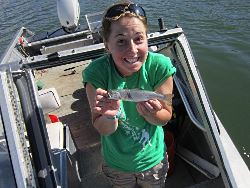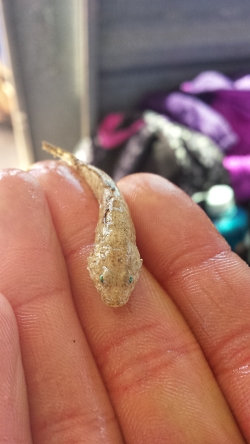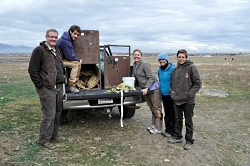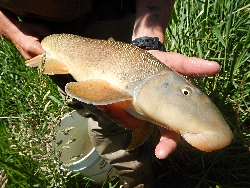
Courtesy & © Bryan Maloney, Photographer
 Bluehead Sucker
Bluehead Sucker
Courtesy & © Bryan Maloney, Photographer
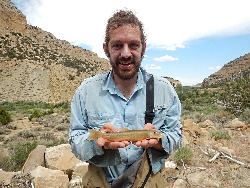 Bluehead Sucker
Bluehead Sucker
Courtesy & © Bryan Maloney, Photographer
 Bluehead Sucker Survey, Ferron Creek, Ferron Canyon, Manti-La Sal National Forest, Emery County, Utah, Courtesy & © Bryan Maloney, Photographer
Bluehead Sucker Survey, Ferron Creek, Ferron Canyon, Manti-La Sal National Forest, Emery County, Utah, Courtesy & © Bryan Maloney, Photographer
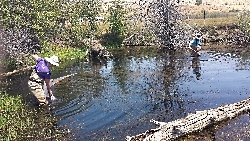 Bluehead Sucker Netting Survey
Bluehead Sucker Netting Survey
Courtesy & © Bryan Maloney, PhotographerAlong the bottom of the Weber River lives a genetically-distinct fish called the bluehead sucker.
Its head is colored in dusty shades of blue, brown and gold. From the gills to the tail the fish has a pattern of gold, diamond-shaped scales with dark brown borders, which grow larger and more distinct closer to the tail.
Its large rounded nose overhangs the papillae-covered lips and mouth, which are set low to allow the fish to eat algae off surfaces.
Another distinguishing feature is its large size the adult bluehead suckers can reach a length of 16-18 inches.
One of the main benefits of the bluehead sucker in the Weber River, is its place in the food web, primarily eating algae. The cartilage scraping edges of its jaws make it easy to feed off rocks and other objects where algae may build up.
The suckers obtain nutrients from the algae, and grow to be good bait and forage fish.
Dr. Phaedra Budy, Unit Leader for the U.S Geological Survey Cooperative Fish & Wildlife Research Unit at USU said, “When both bluehead suckers and trout exist together, the suckers help take the predator pressure off of the game fish, and its feeding habits offer little competition with trout.”
This native species has intrinsic value to the river because of its ability to indicate the health of the riverine ecosystem. But changes in the river have created challenges for the sucker by limiting its habitat.
The river no longer has the freedom to meander across the landscape since it is confined by rail tracks, highways, and urban development for much of its reach. There are also two 150-foot dams and reservoirs in its path. These changes have altered both the physical and thermal characteristics and decreased the spawning habitat of the sucker.
Bryan Maloney, a former graduate student in Dr. Budy’s lab, recently completed his Master’s on the bluehead sucker. His research included determining what spawning habitat the bluehead suckers use.
To do this, Maloney compared the spawning bluehead suckers in Weber River to the ones in the pristine Ferron Creek. This comparison was essential since he needed to see what the spawning suckers chose in the unaltered streams.
Budy explains, if we only studied Weber it would be similar to observing a student who rented a really bad apartment for a semester because he was broke – then saying, “Oh, this must be what he likes to live in,” and not recognizing he would have chosen something much better if he had the resources.
By comparing the two rivers, Maloney discovered the spawning suckers use wide channels with plenty of pools, gravel, and cobble. Once the eggs hatch, the juvenile suckers use nearshore locations where the water is slow and deep and the young suckers find it easier to hide, eat, and grow.
According to Maloney, “These diverse habitat components are critical for spawning adult and growing juvenile bluehead suckers. Restoring them to the Weber River, will assist in recovering this imperiled population.”
Although Weber River is limited in these habitat characteristics, the future of the riverine ecosystem is optimistic due to the formation of the Weber River Partnership.
The agencies in the partnership include Utah Division of Wildlife Resources, Trout Unlimited, Weber Basin Water Conservancy District, both the Weber River and Provo River Water Users Associations, City of Ogden, PacifiCorp, Bureau of Reclamation, and the Davis and Weber Counties Canal Company.
Plans are underway for the fish habitat restoration in the Weber River, which will be a big help to the future of bluehead suckers, and whatever steps are taken to benefit habitat for suckers will also benefit the native trout.
This is Shauna Leavitt for Wild About Utah.
Credits:
Theme: Courtesy & Copyright Don Anderson Leaping Lulu
Photos: Courtesy and Copyright Bryan Maloney
Text: Shauna Leavitt
Sources & Additional Reading
Bluehead Sucker, Utah Conservation Data Center, Utah Division of Wildlife Management, https://fieldguide.wildlife.utah.gov/?species=catostomus%20discobolus [Link updated January 2024]
Thompson, Paul D., Bonneville Cutthroat Trout and Bluehead Sucker in the Weber River: Endangered Species Act Implications, Utah Division of Wildlife Resources, Jun 15, 2015, https://www.slideshare.net/PaulThompson47/weber-river-partnership-native-species-presentation
Webber, P. Aaron, Thompson, Paul D. and Buddy, Phaedra, Status and Structure of two Populations of the Bluehead Sucker(Catostomus discobolus) in the Weber River, Utah, https://www.usu.edu/fel/publications/pdf/Webber_et_al_%202012_BLH_Weber.pdf
Budy, Phaedra; Thiede, Gary P; Mckay, Samuel; Weber River metapopulation structure and source-sink dynamics of native fishes, 2011-2013, https://www.usu.edu/fel/research/weber-river/
Blueheads and Bonnevilles Restoration Project Inspires Weber River Partnership, National Fish Habitat Partnership, October 19, 2016, https://www.fishhabitat.org/news/blueheads-and-bonnevilles-restoration-project-inspires-weber-river-partners
Weber River Partnership Protects World-Class Fishery, Paul Thompson, Guest Blogger, Utah Department of Environmental Quality, https://deq.utah.gov/news/tag/bluehead-sucker






